
Weevils are beetles belonging to the superfamily Curculionoidea, known for their elongated snouts. They are usually small – less than 6 mm in length – and herbivorous. Approximately 97,000 species of weevils are known. They belong to several families, with most of them in the family Curculionidae. It also includes bark beetles, which while morphologically dissimilar to other weevils in lacking the distinctive snout, is a subfamily of Curculionidae. Some other beetles, although not closely related, bear the name "weevil", such as the biscuit weevil, which belongs to the family Ptinidae.

Otiorhynchus is a large genus of weevils in the family Curculionidae. Many species of the genus, particularly the black vine weevil and the strawberry root weevil, are important pests, both as larvae and as adults. Larvae feed on plant roots. Adults are flightless with fused elytra and feed at night on plant foliage. In many species of the genus at least some races are polyploid and parthenogenetic, while the rest of the races and species are diploid and bisexual. Otiorhynchus weevils, particularly O. scaber, have been a popular subject for studies of the evolution of parthenogenesis. The genus is native to the Palearctic region. However, sixteen species were inadvertently introduced to North America and have become widespread there.

The Entiminae are a large subfamily in the weevil family Curculionidae, containing most of the short-nosed weevils, including such genera as Entimus, Otiorhynchus, Phyllobius, Sitona, and Pachyrrhynchus. In comparison with their stunning diversity, only a few of these weevils are notorious pests of major economic importance. Entimines are commonly encountered in the field, including urban environments, and abundant in entomological collections.

Sitonini is a tribe of weevils in the Entiminae subfamily. There are currently 9 extant genera, and one fossil genus, Sitonitellus.
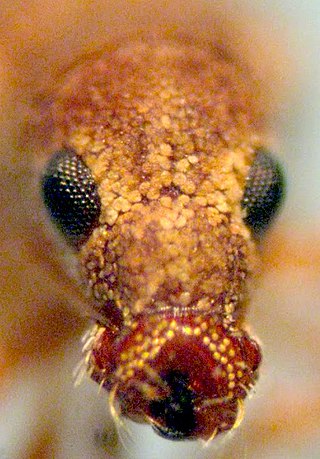
The Anypotactini are a Neotropical weevil tribe in the subfamily Entiminae. It includes 81 described species.

Eustylini is a primarily Neotropical weevil tribe in the subfamily Entiminae.
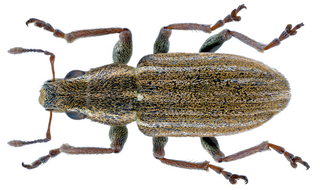
Sitona lineatus, commonly known as the pea leaf weevil is a species of weevil with a Palearctic distribution. It is a common pest of beans, peas, and other plants in the family Fabaceae. Adult beetles of S. lineatus measure 3.4-5.3 mm in length. They are characterized by a series of colored scales arranged in alternating lines (striae) on the elytra; it is from this characteristic where the species gets its name lineatus meaning 'lined' or 'striped'. The head and pronotum also have fine pointed setae amongst the scales. The antennae are clubbed, pointed and preceded by 7 segments. The femora is dark, but tibiae and tarsi are red. As a member of Order Coleoptera (beetles) their forewings are modified to form hardened covers over the thorax and abdomen, with the hindwings for flight underneath.

Sitona sulcifrons is a species of weevil native to Europe.

Sitona striatellus is a species of weevil native to Europe.

Sitona macularius is a species of weevil native to Europe.

Sitona hispidulus is a species of weevil native to Europe. Invasive to Asia and North America.

Barypeithes pellucidus is a species of weevil native to Europe. It has been found in North American hardwood forests for over a century. Larva eat roots and overwinter underground.

Pachnaeus is a genus of broad-nosed weevils in the family Curculionidae. There are about seven described species in Pachnaeus.

Otiorhynchus meridionalis, the lilac root weevil, is a species of broad-nosed weevil in the family Curculionidae. It is found in North America. Lilac root weevils are shiny, brownish-black beetles, about 0.25 inches (0.6 cm) with long snout (rostrum) and geniculate (elbowed) antennae. They are common landscape pests, feeding on lilac, euonymous and peonies.

Artipus is a genus of broad-nosed weevils in the beetle family Curculionidae. There are about 10 described species in Artipus.

Eudiagogus is a genus in the beetle family Curculionidae. They are commonly known as sesbania clown weevils, in reference to the fact that they eat plants of the genus Sesbania. There are about five described species in Eudiagogus.
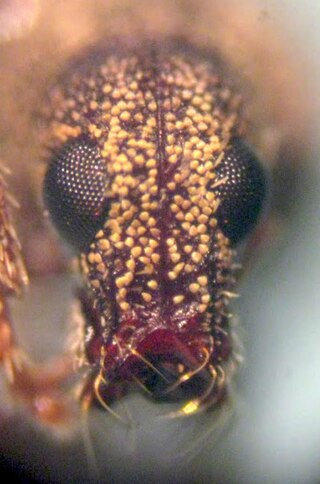
Polydacrys is a genus of broad-nosed weevils in the beetle family Curculionidae, subfamily Entiminae, tribe Anypotactini, present across the Americas and the Caribbean. There are eight described species in Polydacrys.
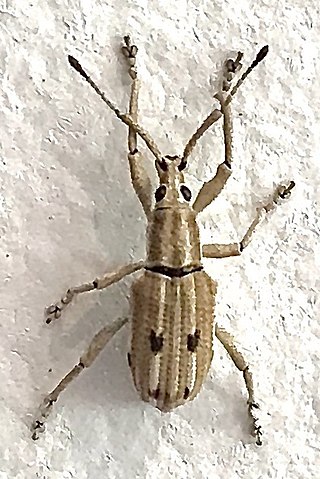
Eustylus is a neotropical genus of broad-nosed weevils in the subfamily Entiminae, tribe Eustylini.
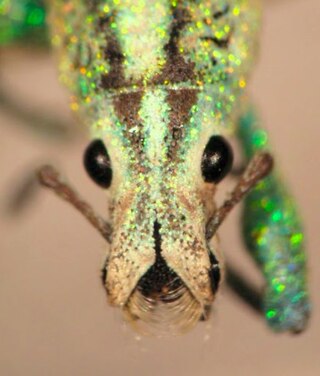
Oxyderces is a genus of broad-nosed weevils in the family Curculionidae distributed in South America. It can be recognized by the presence of dense setae on the apex of the rostrum and postocular setae.
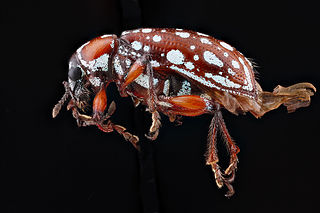
Lachnopus is a genus of broad-nosed weevils in the family Curculionidae distributed in the Caribbean Region.




















